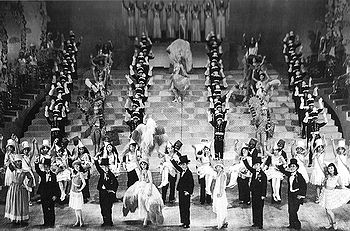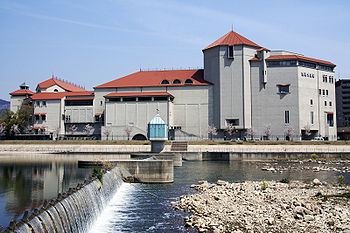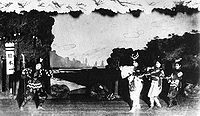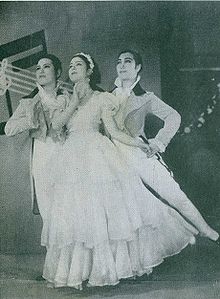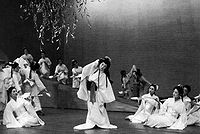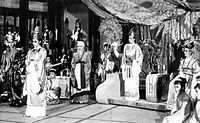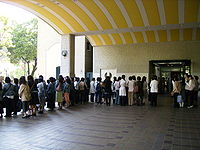- Takarazuka Revue
-
The Takarazuka Revue (宝塚歌劇団 Takarazuka Kagekidan) is a Japanese all-female musical theater troupe based in Takarazuka, Hyōgo Prefecture, Japan. Women play all roles in lavish, Broadway-style productions of Western-style musicals, and sometimes stories adapted from shōjo manga and Japanese folktales. The troupe takes its name from the Hankyu Takarazuka rail line in suburban Osaka. The company is a division of the Hankyu Railway company; all members of the troupe are employed by the company.
Contents
History
The Takarazuka Revue was founded by Ichizo Kobayashi, an industrialist-turned-politician and president of Hankyu Railways, in Takarazuka, Japan in 1913. The city was the terminus of a Hankyu line from Osaka and already a popular tourist destination because of its hot springs. Kobayashi believed that it was the ideal spot to open an attraction of some kind that would boost train ticket sales and draw more business to Takarazuka. Since Western song and dance shows were becoming more popular and Kobayashi considered the Kabuki theater to be old and elitist,[1] he decided that an all-female theater group might be well received by the general public.
The Revue had its first performance in 1914. Ten years later, the company had become popular enough to obtain its own theater in Takarazuka, called the Dai Gekijō meaning “Grand Theater”.[2] Today, the company owns and operates another theater, the Takarazuka Theater, in Tokyo.[3] Currently Takarazuka performs for 2.5 million people each year[citation needed] and the majority of its fans are women.
Part of the novelty of Takarazuka is that all the parts are played by women, based on the original model of Kabuki before 1629 when women were banned from the theater in Japan.[4] The women who play male parts are referred to as otokoyaku (literally "male role") and those who play female parts are called musumeyaku (literally "daughter's role"). The costumes, set designs and lighting are lavish, the performances melodramatic. Side pathways extend the already wide proscenium, accommodating elaborate processions and choreography.
Regardless of the era of the musical presented, period accuracy is relaxed for costumes during extravagant finales which include scores of glittering performers parading down an enormous stage-wide staircase and a Rockette-style kick line. Lead performers portraying both male and female roles appear in the finale wearing huge circular feathered back-pieces reminiscent of Las Vegas or Paris costuming.
Before becoming a member of the troupe, a young woman must train for two years in the Takarazuka Music School, one of the most competitive of its kind in the world. Each year, thousands from all over Japan audition. The 40 to 50 who are accepted are trained in music, dance, and acting, and are given seven-year contracts. The school is famous for its strict discipline and its custom of having first-year students clean the premises each morning.
The first year, all women train together before being divided by the faculty and the current troupe members into otokoyaku and musumeyaku at the end of the year. Those playing otokoyaku cut their hair short, take on a more masculine role in the classroom, and speak in the masculine form.
The company has five main troupes: Hana, Tsuki, Yuki, Hoshi, and Sora (Flower, Moon, Snow, Star, and the Cosmos respectively), and Senka (Superior Members), a collection for senior actresses no longer part of a regular troupe who still wish to maintain their association with the revue and perform from time to time. Flower and Moon are the original troupes, founded in 1921. Snow Troupe began in 1924. Star Troupe was founded in 1931, disbanded in 1939, and reestablished in 1948. Cosmos, founded in 1998, is the newest troupe.
Actors of Takarazuka
While on the surface it would appear that the Takarazuka Revue was intended to grant Japanese women freedom from social oppression, ironically, it began as quite the opposite. According to Takarazuka scholar Lorie Brau, “The production office and corporate structure that control Takarazuka are overwhelmingly patriarchal.”[5] Although Takarazuka embodies Shiraishi’s idea that the actresses become “good wives and wise mothers” upon leaving the company, it also simultaneously represents progressive feminist points of view. Some believe that its appeal to the female audience is on account of the perceived link to freedom from traditional Japanese society’s imposed ideas of gender and sexuality. So while Takarazuka “reinforces the status quo and sublimates women's desires through its dreamy narratives, there remains some possibility that certain spectators find it empowering simply to watch women play men.”[5]
Some Takarasienne shows, such as The Rose of Versailles and Elisabeth, feature androgynous characters. Ryosei and chusei are two Japanese terms used to refer to androgyny, chusei meaning “neutral” or “in between,” neither man nor woman, and ryosei referring to the combination of the sexes or genders.[6][page needed] The otokoyaku represents the woman’s idealized man without the roughness or need to dominate, the “perfect” man who can not be found in the real world. It is these male-roles that offer an escape from the strict, gender-bound real roles lauded in Japanese society.[5] In a sense, the otokoyaku provides the female audience with a “dream” of what they desire in reality.
In addition to their claim to “sell dreams”, the actresses of the Takarazuka Revue take on another role, empowering themselves as women in a male-dominated culture. Kobayashi's desire to make his actresses into good wives and mothers has often been hindered by their own will to pursue careers in the entertainment business. It is becoming increasingly more common for women to stay in the company well into their thirties, beyond the conventional limits of marriageable age. The actresses’ role within the Takarazuka Revue thus overlaps into the culture surrounding it, adding to their appeal to the female-dominant audience. “In fact, it is the carrying over of this 'boyishness' into everyday life and the freedom that this implies that captures the attention of some fans.”[5] The otokoyaku, however, is not bound to her assigned male role in the theater. Tsurugi Miyuki, top otokoyaku star of the Moon Troupe, said that she conceived male impersonation as just a "role" that she wore like the makeup and costume that helped create her otokoyaku image. She said she reverts to her nonperforming “feminine” self after performance.[5]
Although traditionally an all-female troupe, in 1946 the Takarazuka employed male performers who were trained separately from the female members of the troupes. Ultimately, however, the female members opposed these new male counterparts, and the department was dissolved, the last male department terminating in 1954. A recent Japanese musical, Takarazuka Boys, was based on this chapter of the company's history.
While the casts are all-female, the staff (writers, directors, choreographers, designers, etc.) and orchestra musicians may be male or female. It is not uncommon in Takarazuka for a predominantly male orchestra to be led by a female conductor.
The troupes
The five troupes of the Takarazuka Revue have certain differences of style and material which make each unique.
Flower Troupe (Hana)
The Flower Troupe is considered the "treasure chest" of otokoyaku. Many of the most popular former and current top stars of the company originated in Flower Troupe; these include Sumire Haruno of Flower, Jun Shibuki, Jun Sena and Kiriya Hiromu of Moon, and Hikaru Asami of Snow. Their performances tend to have larger budgets, with lavish stage and costume designs, and are often derived from operatic material.
Moon Troupe (Tsuki)
While tending to be a home for young performers (with Yūki Amami in her sixth year reaching the status of top star in the 1990s), the members of Moon Troupe are also strong singers. The term "Musical Research Department" is occasionally used in articles about the troupe, underscoring the troupe's focus on music. Their material tends toward drama, Western musicals, and modern settings, such as Guys and Dolls and Me and My Girl. During the era of Makoto Tsubasa as top star, they had at least two musicals adopted from classic western novels.
Snow Troupe (Yuki)
Snow Troupe is considered the upholder of traditional dance and opera for the whole company, being the vanguard of traditional Japanese drama in a company that tends towards Western material. They were the first troupe to perform Elisabeth in Japan. The troupe has been moving towards the opera and drama style of Moon and Flower.
Star Troupe (Hoshi)
Star Troupe tends to be the home of Takarazuka's stars. They, along with Flower Troupe, have very strong otokoyaku players. In recent years, many of the company's prominent musumeyaku have also originated from Star Troupe, such as Hana Hizuki, Shizuku Hazakura, and Yuki Aono.
Cosmos Troupe (Sora)
Cosmos, the newest troupe, is less traditional and more experimental. When it was first formed, it culled talent from the other troupes. The Cosmos style is influenced by performers like Asato Shizuki, the founding otokoyaku top star; Yōka Wao and Mari Hanafusa, the "Golden Combi" who headed the troupe for six of its first eight years. Cosmos were the first troupe to perform Phantom and to have a Broadway composer (Frank Wildhorn) write their musical score. Most of the otokoyaku in this troop are above 170 cm (the most notable is Hiro Yuumi, the tallest in the company since she joined in 1997).
Types of musicals performed by Takarazuka
Adaptations of Western works
While the majority of Takarazuka works are written "in house" by members of the creative staff, they are often adapted from Western classic musicals, operas, plays, novels or films:
Adaptations of Japanese works
Stories based in Japan and modeled on historical accounts or traditional tales, are often referred to as nihonmono (日本物) or, less frequently, wamono (和物). Among the most common of these adapted to the Takarazuka stage is The Tale of Genji (源氏物語 Genji Monogatari).
Popular manga series have often shaped Takarazuka, such as in the case of Riyoko Ikeda's The Rose of Versailles. Other manga adaptations include The Window of Orpheus, also by Ikeda, Osamu Tezuka's Black Jack and Phoenix, and Yasuko Aoike's El Halcón.
Recent examples of works adapted from Japanese novels or short stories include Moon Troupe's Osaka Samurai (大阪侍 Oosakazamurai), based upon the short story by Ryōtarō Shiba, and Flower Troupe's Black Lizard (黒蜥蜴 Kurotokage), based upon the Kogoro Akechi story by Edogawa Rampo.
In 2009, Takarazuka Revue performed two shows based on an adaptation of Capcom's videogame series Phoenix Wright.[7]
Adaptations of other Asian works
Among works adapted from other Asian sources is the Beijing opera Farewell My Concubine, detailing the romance between General Xiang Yu and his lover Madam Yu.
Original Stories and Historical Adaptations
Musicals have also been performed throughout the years based upon people and events in American, European, and Asian history. Among the more recognizable of these biographical adaptations are Last Party: S. Fitzgerald's last day, about F. Scott Fitzgerald, Valentino, about Rudolph Valentino, and Dean, about James Dean.Finally, original stories round out Takarazuka fare, including musicals such as Boxman by Cosmos Troupe and Silver Wolf performed by Moon and Snow Troupes.
Collaborations
Takarazuka has occasionally worked with notable writers, composers, and choreographers to create original content for the revue. In 1993, Tommy Tune wrote, directed and choreographed the revue Broadway Boys to accompany Moon Troupe's rendition of Grand Hotel. In 2006, Takarazuka worked with Frank Wildhorn, musical writer and composer of Jekyll & Hyde and The Scarlet Pimpernel, to create Never Say Goodbye for Cosmos Troupe.Personnel
Star personnel
The current top stars of each group are:
Group otokoyaku musumeyaku Senka Yū Todoroki[1] Flower Tomu Ranju Hana Ranno Moon Kiriya Hiromu Yuki Aono Snow Kei Otozuki Mimi Maihane Star Reon Yuzuki Nene Yumesaki Cosmos Yūhi Ozora Sumika Nono ^ The youngest member to ever serve on the board of directors
Other performers in the company
Group Flower Moon Snow Star Cosmos Otokoyaku Kazuho Sou, Harei Aine, Hikaru Hanagata, Manato Asaka Izumi Aoki, Kaito Seijou, Masaki Ryū, Rio Asumi Aki Misuzu, Oto Ayana,[2] Tooma Ozuki, Seina Sagiri, Kurama Saou Shio Suzumi, Seika Yumeno, Yuzuru Kurenai, Suzuho Makaze Hiro Yuumi,[3] Kairi Hokushō, Irisu Toki, Kaname Ouki, Ruumi Nagina Musumeyaku Ichika Sakura, Juria Hanano Yurino Touka, Rion Ayahoshi Ayu Manaka, Ami Yumeka Seara Hisaki, Remi Shirahana Chitose Junya, Rei Sumireno ^ The younger sister of Nao Ayaki, the former top star (otokoyaku) of Moon Troupe
^ The tallest actress in the entire companySeniority
The terms upperclassmen (上級生) and lowerclassmen (下級生) (the Japanese terms are gender-neutral) are used to distinguish senior and junior members of Takarazuka. Lowerclassmen are the actresses who have been performers in Takarazuka for less than seven years. They are employees of the company, and usually work as background dancers and in shinjin kōen (performances exclusively for underclassmen). After the seventh year they become upperclassmen, and negotiate contracts with the company instead of being employed by it.
Former Takarasiennes
Takarazuka roster members who went on to work in stage, movies and television include:
otokoyaku musumeyaku - Ran Ohtori
- Rei Asami
- Maki Ichiro
- Keaki Mori
- Yūki Amami
- Mao Daichi
- Fubuki Takane
- Miki Maya
- Midori Hatsukaze
- Sakiho Juri
- Mayo Suzukaze
- Jun Shibuki
- Asato Shizuki
- Nao Ayaki
- Yōka Wao
- Wataru Kozuki
- Hikaru Asami
- Sumire Haruno
- Kei Aran
- Kei Takeshiro
- Makoto Tsubasa
- Maya Misato
- Mao Ayabuki
- Natsuki Mizu
- Risa Junna
- Hitomi Kuroki
- Mahiru Konno
- Rei Dan
- Miyo Fuzuki
- Mari Hanafusa
- Rira Maikaze
- Rui Shijō
- Kanami Ayano
- Yuri Shirahane
- Yukiko Todoroki
- Aya Izumo
Takarazuka's audience
Women make up the primary audience of Takarazuka; in fact, some estimates say the audience is 90 percent female.[5] There exist two primary theories as to what draws these women to Takarazuka. One is that the women are drawn to its inherent lesbian overtones. One author states, “It was not masculine sexuality which attracted the Japanese girl audience but it was feminine eroticism”.[8] The competing theory is that the girls are not drawn to the implicit sexuality of Takarazuka, but instead are fascinated by the otokoyaku (the women who play male roles) “getting away with a male performance of power and freedom”.[9]
Favoring the first theory, American Jennifer Robertson[10] observes that lesbian themes occur in every Takarazuka performance, simply by virtue of the fact that women play every role. The audience clearly picks up on it and responds. Within the first ten years of Takarazuka's founding, the audience was vocally responding to the apparent lesbianism. Female fans wrote love letters to the otokoyaku. In 1921 these letters were published and several years later newspapers and the public rallied a cry against Takarazuka, claiming it was quickly becoming a “symbol of abnormal love”. In order to combat this, the producers kept its actresses in strict living conditions; they were no longer allowed to associate with their fans.[6] Robertson mentions a phenomenon of “S” or “Class S” love, a particular style of love wherein women who have been influenced by Takarazuka return to their daily lives feeling free to develop crushes on their female classmates or coworkers.[citation needed] This type of romance is typically fleeting and is seen in Japanese society as more of a phase in growing up rather than "true" homosexuality.[8] Robertson sums up her theory thus: "Many [women] are attracted to the Takarazuka otokoyaku because she represents an exemplary female who can negotiate successfully both genders and their attendant roles and domains.”[6]
The competing theory, supported by Canadian Erica Abbitt,[11] is that the female audience of Takarazuka is drawn not exclusively by lesbian overtones, but rather by the subversion of stereotypical gender roles. Japan is a society notorious for its rigid conception of gender roles. While the original goal of the show may have been to create the ideal good wife and wise mother, off stage, on-stage gender roles are, by necessity, subverted. The otokoyaku must act the way men are supposed to act. Abbitt insists that a large portion of the appeal of Takarazuka comes from something she calls “slippage”, referring to the enjoyment derived from a character portraying something they are not, in this case a woman portraying a man. While not denying the presence of lesbian overtones within Takarazuka, Abbitt proposes the cause for the largely female audience has more to do with this subversion of societal norms than sexual ones.[9]
Fan clubs
Some fans demonstrate their loyalty to a particular performer by joining her fan club. Club members can be identified by their wearing scarves of a particular color or even jackets colorfully embroidered with the star's name. Following performances at the Takarazuka Grand Theatre or Tokyo Takarazuka Theatre, as many as several hundred fans congregate in their various club groups and stand in orderly ranks on either side of the street in front of the theatre. The clubs are arranged by actress seniority within the troupe. Theatre officials set up barricades and oversee the assembly.
Whenever an actress exits the theatre, the frontmost group will sit and all the others follow suit (much like the "wave" seen in athletic arenas) with subsequent intervals of standing and sitting. The fans wait patiently, with little conversation, for their favorites to exit the theatre,[12] their decorum contrasting markedly to the noisy, competitive and often pushy autograph-seekers who wait outside stage doors in the West. An almost eerie ritualistic calm prevails. As the stars come out of the building one by one, some alone but most accompanied by staff members of their club, orderly quiet continues to prevail. The glamorous performers, now mostly in slacks or jeans with high heels and wearing oversize visored "newsboy" caps to hide their hair (and some with sunglasses even at night), move along to their own particular fan clubs. Rather than requesting autographs, the fans proffer cards, which are gathered efficiently by each star, who may say a few words but then waves and moves on. Once the last stars have emerged and departed, the clubs disband quietly.
Influence
Takarazuka has had a profound influence on the history of anime and manga, especially shōjo manga.[13] Osamu Tezuka, a highly influential manga creator, grew up in the town of Takarazuka. His mother knew many of the Takarazuka actresses, and as a child he knew them and watched many of their performances.[13][14] Based on their stories of noble princes played by female actresses,[13] Tezuka created Princess Knight[15] the first manga aimed at a female audience, which tells the story of Princess Sapphire, a girl born with both a male and female heart who struggles between the desire to fight as a noble prince and to be a tender, gentle princess. The great success of Princess Knight and other Tezuka stories began the tradition of manga written for a female audience, especially the very influential Rose of Versailles and Revolutionary Girl Utena series, both of which borrow directly from Princess Knight by including specific Tezuka images, character designs and names. Rose of Versailles is one of Takarazuka's best-known musicals. Women in masculine roles continue to be a central theme in shōjo manga and anime as well as some shōnen, and Tezuka himself explored the theme in many of his later works, including Dororo, Phoenix and Black Jack.
While the influence of Osamu Tezuka and Takarazuka on anime and manga is general, there are still many series which show more specific influences. The Takarazuka Revue inspired the plot of the original Sakura Wars video game, along with additional inspiration from Takarazuka's one-time competitor the Shochiku Kagekidan (Shochiku Revue).[16] In regards to Sakura Taisen, not only did the Kagekidan inspire the plot for Sakura Taisen, it also strongly influenced the organization of the characters, namely the Hanagumi.
The Zuka Club in Ouran High School Host Club is based on the Takarazuka Revue. The characters Haruka Tenoh and Michiru Kaioh of Sailor Moon were loosely based on the actors of the Takarazuka Revue.[17]
Takarazuka and homosexuality in Japanese society
For a society that has been at least contextually accepting of homosexuality for most of its history, Japan is surprisingly biased against lesbian activity, apparent in Takarazuka's early history. After the scandal of women writing love letters to the otokoyaku and the revelation of an actual lesbian relationship between a otokoyaku and a musumeyaku, Takarazuka greatly limited itself in order to do away with the lesbian image. Women wore militaristic uniforms, heightening the attraction even more among some. In August 1940, the actresses were even forbidden to answer fan mail and socialize with their admirers.[6][page needed]
In the years since then, the regulations have relaxed but not by much. There was another scandal when, for the first time, one of the otokoyaku cut her hair short (previously all of the actresses had their hair long and the otokoyaku simply hid their hair under hats).[6][page needed]
See also
- Films from Takarazuka Revue produced by Takarazuka Eiga.
- Breeches role
- Cross-dressing
References
- ^ Kobayashi Ichizo. “Takarazuka Manpitsu (1955)”. Tokyo, Daiyamondsha. 1961. Kobayashi Ichizo 2: 445-46.
- ^ Kawatake, Toshio. “A History of Japanese Theater II: Bunraku and Kabuki”. Kokusai Bunka Shinkokai. Tokyo. 1971. pp.15-52.
- ^ Takahara, Kanako, "Fans make troupe phenomenon it is", Japan Times, June 23, 2009, p. 3.
- ^ Leupp, Gary P. Male Colors: The Construction of Homosexuality in Tokugawa Japan. University of California Press, 1997. ISBN 0520209001.
- ^ a b c d e f Lorie Brau. ""The Women’s Theatre of Takarazuka." TDR 34.4 :79-95.
- ^ a b c d e Robertson, Jennifer. “Takarazuka: Sexual Politics and Popular Culture in Modern Japan.” Berkeley: University of California Press, 1998.
- ^ http://www.capcom.co.jp/gyakutensaiban/takarazuka_index.html
- ^ a b Dollase, Hiromi (2003). "Early Twentieth Century Japanese Girls' Magazine Stories: Examining Shōjo Voice in Hanamonogatari (Flower Tales)". The Journal of Popular Culture 36 (4): 724–755. doi:10.1111/1540-5931.00043. OCLC 1754751.
- ^ a b Abbitt, Erica Stevens. “Androgyny and Otherness: Exploring the West Through the Japanese Performative Body”. Asian Theatre Journal 18.2: 249-256.
- ^ http://sitemaker.umich.edu/jennifer.robertson/jennifer_robertson
- ^ Prof. Erica Abbitt's webpage at the University of Windsor, Canada
- ^ The feminine `kabuki' alternative
- ^ a b c Randall, Bill (May 15, 2003). "Three By Moto Hagio". The Comics Journal (252). http://www.tcj.com/index.php?option=com_content&task=view&id=283&Itemid=48. Retrieved 2008-01-23.
- ^ Gravett, Paul (2004). Manga: 60 Years of Japanese Comics. Harper Design. p. 77. ISBN 1-85669-391-0.
- ^ Welker, James (2006). "Beautiful, Borrowed, and Bent: "Boys' Love" as Girls' Love in Shōjo Manga". Signs: Journal of Women in Culture and Society 31 (3): 841. doi:10.1086/498987.
- ^ Interview with Ouji Hiroi, partially translated at the Takarazuka Revue Community LiveJournal page. With regard to Sakura Taisen, not only did the Kagekidan inspire the plot for Sakura Taisen, it also strongly influenced the organization of the characters, namely the Hanagumi. Retrieved on 19 July 2007
- ^ Takeuchi, Naoko (October 1, 1999). Materials Collection. Translated by Alex Glover. Japan: Kodansha. http://www.kurozuki.com/takeuchi/sailormoon/settei.html. Retrieved 10 October 2006. ""[Haruka] plays a male role in Takarazuka.""
General references
- Robertson, Jennifer Ellen (1998). Takarazuka: Sexual Politics and Popular Culture in Modern Japan. Berkeley and Los Angeles, Calif.: University of California Press. p. 50. ISBN 0-520-21150-2 (hardcover); ISBN 0-520-21151-0 (paperback).
- The Politics of Androgyny in Japan: Sexuality and Subversion in the Theater and Beyond Jennifer Robertson American Ethnologist, Vol. 19, No. 3 (Aug., 1992), pp. 419-442
Further reading
- Leonie R. Stickland Gender Gymnastics: Performing and Consuming Japan's Takarazuka Revue, Melbourne, Australia: Trans Pacific Press, 2008 Review of Gender Gymnastics
- James Roberson and Nobue Suzuki, Men and Masculinity in Contemporary Japan: Beyond the Salaryman Doxa, London and New York: RoutledgeCurzon, 2003
- Alisa Roost. "Elisabeth." Theatre Journal. Vol 60.2.
- Japanese tradition meets Western musicals — Article on the Takarazuka Revue from the Travel section of The Christian Science Monitor (April 20, 2005).
- Takarazuka - Modern Japan—A travel article on Takarazuka
- TezukaInEnglish.com Takarazuka Page — about the influence of Takarazuka on the founder of Japanese manga Osamu Tezuka
- Revue Sphere—A very nice fan site
- Welcome to Romance Theatre, by K. Avila, Jade Magazine, March 2004.
- Takarazuka Revue photos, by K. Avila, 2004, 2006. Photos of TR theater sites. Production flyers for 2003-2004 season.
External links
- The official Takarazuka Revue website—A brief history and information on their shows
- The Takarazuka Wikipedia—An English-language resource for fans of the Revue, featuring the history of Takarazuka, and databases of Takarasiennes and performances.
Coordinates: 34°48′26″N 135°20′47″E / 34.807177°N 135.346392°E
Categories:- Takarazuka Revue
- Theatre companies in Japan
- Visitor attractions in Hyōgo Prefecture
- Musical theatre companies
Wikimedia Foundation. 2010.


